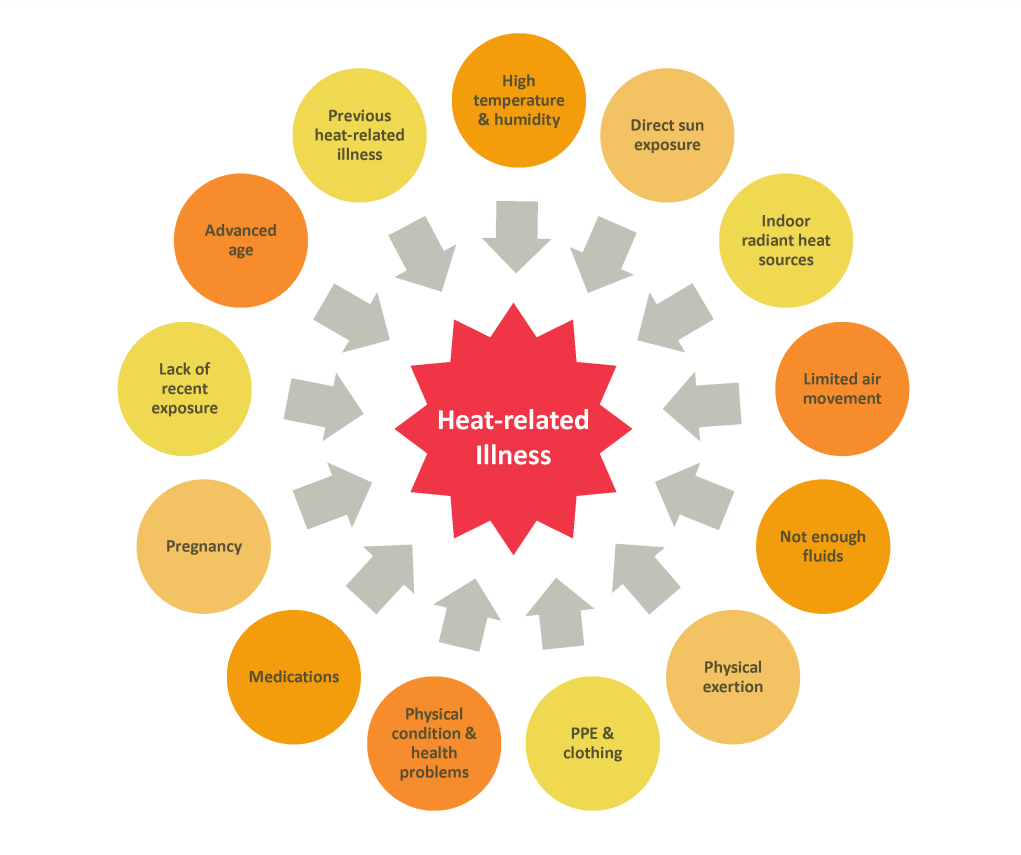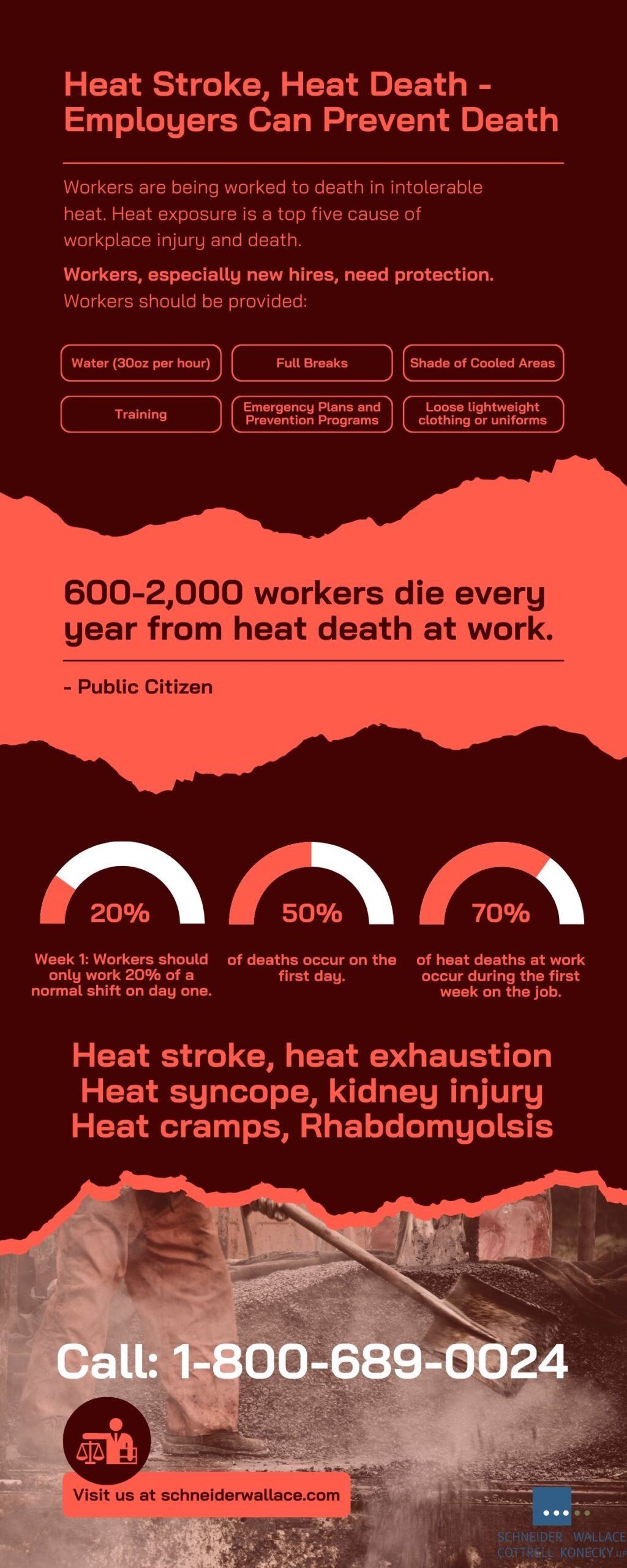Media
Heat Stroke, Heat Syncope, and the Death of New Workers
Workers, especially new workers not accustomed to their environment, can be injured or killed by heat exposure. Older workers, obesity, pregnancy and other factors can combine to increase risk, and by occupation the most common industry for a reported heat death was in construction, followed by agriculture and mining.
Heat stroke, heat exhaustion, syncope, kidney failure or injury and rhabdomyolysis are all possible when a worker is exposed to excessive heat and not given sufficient water, breaks and if working outside shade. While shade is needed for those outdoors, the phenomenon of workers injured by heat is not limited to outdoor labor, workers in factories that overheat are a large part of the total injuries and deaths reported each year.
The Official Numbers Are Incomplete
Official government trackers show a problem but a small one, only 40 or so deaths per year, and several thousand injuries, but due to failure to report and self-reporting mechanisms, it is acknowledged the problem is much larger than tracked by these databases.
When researchers instead relied on a larger more complete data set, workers compensation claims across California, they discovered that it was likely 20,000 additional injuries occurred during high heat than would have occurred in lower temperatures. These 20,000 additional injuries are just for California. For all of the United States, injuries at this rate from heat could exceed 150,000 per year.
Extrapolating out from the CA injury increase in heat, deaths could rise to many hundreds to the low thousands per year. Public Citizen put out an estimate of 600-2000 deaths per year from heat related injury based on an analysis of three studies. This places heat exposure fatalities as one of the most likely causes of death for a worker.
Heat Injuries At Work
These are the most common types of heat related injury:
- Heat Exhaustion: A heat-related illness of excessive heat above 100.5, abnormal function of one or more organs, without injury the central nervous system. The next stage is heat stroke.
- Heat Stroke: Disruption of the central nervous system including convulsions or losing consciousness, lack of sweating, temperature of 106 degrees.
- Exertional Heat Stroke: Heat Stroke occurring in physical active workers, who may continue to sweat. Exertional heat stroke can include break down of skeletal muscle, which can lead to rhabdomyolysis.
- Heat Syncope: Collapse or loss of consciousness due to heat exposure, without a loss of sweating or raise in internal body temperature, similar to fainting but due to heat exposure.
- Kidney Injury: Permanent damage to the kidneys due to heat exposure, can include kidney failure and acute kidney failure.
- Rhabdomyolysis: A medical condition associated with heat stress and prolonged exertion, rapid breakdown and rupture of muscles, resulting in necrosis of the muscle tissue.
Common symptoms of each injury:
- Heat Exhaustion: Headache, nausea, dizziness, weakness, irritability, thirst, heavy sweating, rising body temperature, decreased urine output.
- Heat Stroke: Heat exhaustion symptoms plus confusion, slurred or altered speech, loss of consciousness, seizures, further increased body temperature, danger of a fatal outcome.
- Heat Syncope: Fainting, dizziness, light-headedness during standing or sudden rise from sitting position.
- Rhabdomyolysis: Muscle cramps, muscle pain, dark urine, weakness, exercise intolerance, nausea, back or abdominal pain, however the person may also be asymptomatic by appearance.
As an exhausted worker suffering from heat exhaustion progresses to heat stroke and rhabdomyolysis, the prolonged heat stress results in breakdown of their muscle tissue. As the muscle tissue breaks down, necrosis affects the damaged tissue releasing large proteins and electrolytes. Potassium is an electrolyte which can cause heat arrhythmia and seizures at large levels in the body. Another concern is kidney damage including the possibility of acute kidney failure.
Heat-Related Illness Risk Factors
Everyone can suffer from heat exposure, but there are additional risk factors that can increase the odds of a heat-related injury or death.
Risk factors include: High temperature, high humidity, sun exposure, indoor radiant heat sources, limited air flow, insufficient water access and water consumption, physical exertion, clothing including protective equipment, workers physical condition, existing health problems, medications, pregnancy, lack of acclimatization, older workers. An additional risk factor is having had previous heat-related illness.
Inexperienced With Heat – Workers New on the Job Die First
Acclimation of new workers to high heat, whether they are new to the job or new to the high heat work day, is critical to preventing heat-related injury and death.
Half of deaths from overheating at work were among workers working their very first shift in high heat. They died from their first day of exposure. Seventy percent of deaths occurred among workers with less than two weeks experience in high heat environments.
The CDC recommends workers slowly ramp up to hot conditions over 14 days. For new workers, a schedule of no more than 20% of the usual exertion and work during exposure to a hot environment is recommended. Increasing from there by no more than 20% per day.
For workers with experience in heat, acclimatization is still recommended when heat exposure returns after an absence of more than a few days. Workers with a large history of working in the heat can work 50% of their expected work and exertion levels on day 1 of dangerous heat exposure, working up to full capacity over 4 days.
Additional time, for new and experienced workers, is needed if they are not physically fit.
Dying From Overheating
Three studies reviewed heat-related injuries and deaths, with implications for estimating actual worker heat-related death in the United States given official counters are incomplete.
Weinberger et al , “Estimating the number of excess deaths attributable to heat in 297 United States counties”, did exactly as it was titled. The results were an estimated 5,000 heat-related deaths in those counties per year. Working with this data and comparing the frequency of worker injuries compared to government database odds per worker, would result in approximately 600 deaths per year by workers on the job.
Shindell et al, “The Effects of Heat Exposure on Human Mortality Throughout The United States”, placed the figure across the whole united states at 12,000 heat-related deaths per year. Once you compare the results to show a real rate of injury, and assume the real rate of death tracks injury, with 1 in 17 tracked deaths occurring at work, results in 700 deaths per year by workers on the job.
Park et al, “Temperature, Workplace Safety, and Labor Market Inequality” found about 50 times the injuries as government databases covering the same workers. Extrapolating this across the United States, at a tracked 40 deaths per year by government, would result in an estimated 2,000 workers dying per year from heat exposure at work.
Preventing Injury From Heat Exposure
Employers and managers must act to ensure their workplace environment protects workers from injury.
Acclimation of workers to high heat, including additional protections for new workers, remains critical.
Additional standards for employers should include:
- Workload and Pace limits
- Mandatory Rest Breaks
- Indoor Cooling
- Outdoor Cooling
- Heat Stress Plans
- Emergency Response Plans
- Acclimatization Plans
- Hydration
- Worker Training on Heat Exposure
Other basic principles regarding worker safety apply to heat-related illness, such as record keeping to record results and a non-retaliation policy to allow for workers to report incidents and issues before they result in an injury or death.
Creating plans including ones based on temperature and humidity allow managers to act, undefined “excessive heat” guidelines leave managers unsure of when workers are at an elevated danger.
Access to water is insufficient if workers are not trained on and encouraged and allowed to access the water. Water access that can only be accessed during regular breaks will not produce results that water access while working allows. In hot weather workers should be provided with 1 liter of cold water per hour, and heavy workloads in hot weather should require electrolyte beverages. All plans and guidelines should be provided to workers and be a part of training.
Preacclimation is needed for both new and experienced workers when high heat exposure returns after an absence.
A Law Firm for Workers
If you or a loved one has been injured due to conditions at work, Schneider Wallace is known for our aggressive pursuit of injured workers rights through complex litigation and class action lawsuits. To learn more about recovering for lost wages, medical expenses, and injuries, schedule a consultation with our trial lawyers at our Northern California, Southern California, Texas, North Carolina or Puerto Rico office. We practice before state and federal courts in jurisdictions throughout the United States in individual claims, class actions and multidistrict litigation.

